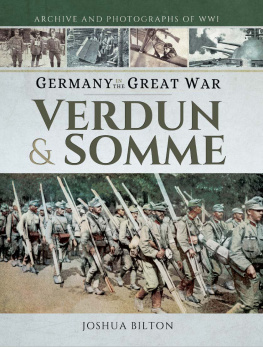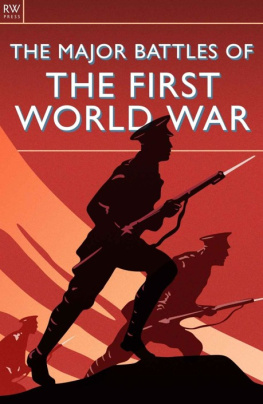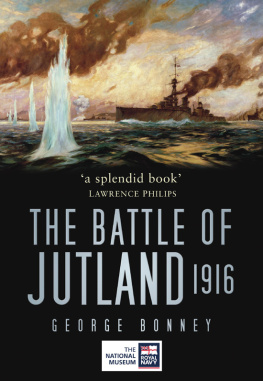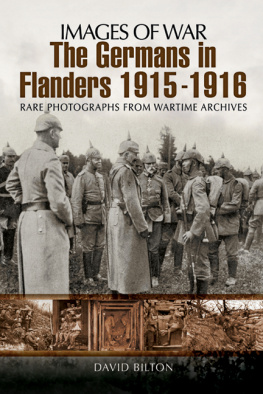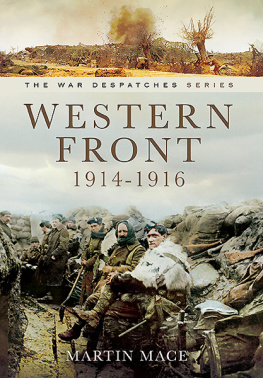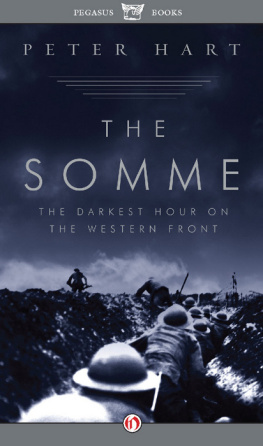Pagebreaks of the print version

GERMANY IN THE GREAT WAR
GERMANY IN THE GREAT WAR
Verdun & Somme
Harold Cook
First published in Great Britain in 2021 by
Pen & Sword MILITARY
An imprint of Pen & Sword Books Ltd
Yorkshire Philadelphia
Copyright Harold Cook, 2021
ISBN: 978 1 47387 689 7
eISBN: 978 1 47387 691 0
Mobi ISBN: 978 1 47387 690 3
The right of Harold Cook to be identified as the Author of this work has been asserted by him in accordance with the Copyright, Designs and Patents Act 1988.
A CIP catalogue record for this book is available from the British Library
All rights reserved. No part of this book may be reproduced or transmitted in any form or by any means, electronic or mechanical including photocopying, recording or by any information storage and retrieval system, without permission from the Publisher in writing.
Pen & Sword Books Limited incorporates the imprints of Atlas, Archaeology, Aviation, Discovery, Family History, Fiction, History, Maritime, Military, Military Classics, Politics, Select, Transport, True Crime, Air World, Frontline Publishing, Leo Cooper, Remember When, Seaforth Publishing, The Praetorian Press, Whamcliffe Local History, Whamcliffe Transport, Whamcliffe True Crime and White Owl.
For a complete list of Pen & Sword titles please contact
PEN & SWORD BOOKS LIMITED
47 Church Street, Barnsley, South Yorkshire, S70 2AS, England
E-mail:
Or
PEN AND SWORD BOOKS
1950 Lawrence Rd, Havertown, PA 19083, USA
E-mail:
Website: www.penandswordbooks.com
Acknowledgements
M any thanks to Dave Bilton, Ann Coulson and Irene Moore for your continued support. Without you this book would not have been published.
Introduction
T his book is the third in a five-part series that documents photographically the exploits of the Central Powers during the First World War. Like previous volumes, this monograph chronicles important aspects of a single year, in this case 1916.
For the Central Powers, it was a year of trial and error, of innovation and drastic changes, with fighting to the west (and the nascent development of Materialschlacht or attrition warfare), to the east and further south.
Seeking to ease the strain on the beleaguered French, Anglo-French forces launched an attack on the Somme, between Gommecourt and Lihons. A combination of poor tactics from inexperienced commanders and soldiers, as well as an effective German defence... checked the British assault, resulting in exceptionally high British losses on the first day of the campaign (1 July).
Part of the German Armys difficulties, both at Verdun and on the Somme, stemmed from the poor performance of Die Fliegertruppe (the Imperial German Flying Corps). Ineffectual by comparison to the British Royal Flying Corps (RFC) and the French Aronautique Militaire , the Imperial German Flying Corps (IGFC) was unable to gain air superiority. Meanwhile, to the east, the situation remained analogous to 1915 with the IGFC unimpeded, capable of providing air-support, over-battlefield reconnaissance and artillery observation.
Verdun demanded additional support on other fronts and coalition forces determined that a second offensive to the East was necessary. Materially inferior and lacking adequate leadership, Russian forces were doomed from the start and an attack at Lake Naroch resulted in approximately 100,000 casualties. German losses were less than a quarter of that figure.
Undeterred, the Russian Stavka (High Command) commenced planning a second offensive forthwith. What materialised was a combined-arms offensive along a 32km front against Austro-Hungarian forces in Galicia; one striking consecutive blows. The offensive effectively destroyed the Austro-Hungarian Army which suffered the majority of the casualties: approximately 616,000. From then on, the Austrian High Command increasingly relied upon the support of their Teutonic counterparts, the German Army.
Meanwhile, along the border between Turkey and Russia, Ottoman troops endeavoured to frustrate the advance of Russian soldiers at Erzurum, Trabzon and Erzincan. Despite their best efforts and mismanagement of manpower, all three towns were occupied within quick succession. Bitlis, too, was seized, the Russian Caucasus Army overwhelming the Ottoman Second Army after months of heavy fighting.
Meanwhile, in Mesopotamia the besieged remnants of General Charles Townsends garrison, situated within the town of Kut Al Amara, were struggling to frustrate the onslaught of the Turkish Army. British units, several redeployed from the Western Front, were similarly unable to penetrate the Ottoman front line and after five months of sustained aggression, Townsend surrendered. Kut offered brighter prospects for the Turkish Army in Mesopotamia than had hitherto been possible.
Conditions on the Home Front were less sanguine. A poor harvest, allied with a paucity of transportation, resulted in a winter of stark deprivation for German and Austro-Hungarian civilians. This situation was further exacerbated by the ever-increasing need to relocate food to the front. A system of rationing, designated sharing scarcity, was introduced and intended to distribute diminishing foodstuffs. Understandably, resentment was manifest and strikes broke out, resulting in smashed windows, the misappropriation of food and, in some cases, fatalities. Malnourishment was therefore widespread, particularly among senior citizens and the young, leading to complications and other maladies. For example, babies born during the First World War were found to be significantly lighter than was customary.
Privation on the Heim Front was a consequence of the economic blockade, imposed by Entente maritime forces and the Kaiserliche Marines (Imperial Navys) failure to frustrate the Royal Navys blockade.
Across all fronts, whether at home or in Poland, citizens and soldiers alike stood fast against Entente forces. Although success was not forthcoming, a stubborn determination to resist was evident and the Central Powers withstood increasing deprivation on the Home Front and across all fronts.
Chapter 1
Westfront
T oday, 1916 is remembered as the year the British Army suffered its worse tragedy in recorded history. At 7.28am on the morning of 1 July, nine corps of the French Sixth Army, along with the British Third and Fourth armies went over the top, from Gommecourt in the north to Montauban in the south. What followed was, in the words of Private E. Houston of the Public Schools Battalion, one hundred times worse than any storm.
Although the word Somme casts a funereal pall over the United Kingdom, its memory is neither universal nor absolute. The campaign is not, as Robin Schfer argued, something that is very much remembered here in France or Germany. For the men of both the Entente and Central Powers, 1916 was dominated by one of two major campaigns: the battles of the Somme and Verdun (two offensives that in later years came to symbolise, if inaccurately, the supposed futility of the First World War).
The latter campaign (noticeably absent from all but the most comprehensive British histories) commenced on 21 February 1916. Soldiers of the German Fifth Army, following a sustained preliminary bombardment, assailed the French front line surrounding Verdun. Incidentally, the citadel was the last position to fall to German soldiers during the Franco-Prussian War of 187071, and was therefore of significant value, both historically and culturally.

